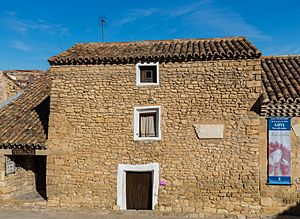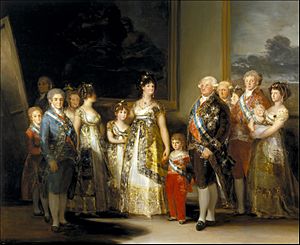Francisco de Goya facts for kids
Quick facts for kids
Francisco Goya
|
|
|---|---|

|
|
| Born |
Francisco José de Goya y Lucientes
March 30, 1746 Fuendetodos, Aragon, Spain
|
| Died | April 16, 1828 (aged 82) Bordeaux, France
|
| Nationality | Spanish |
| Known for | Painting, drawing |
| Movement | Romanticism |
Francisco de Goya y Lucientes (born March 30, 1746 – died April 30, 1828) was a famous Spanish painter. He created many portraits of the Spanish Royal Family. Two of his most famous paintings are Charles IV of Spain and His Family and The Third of May 1808. He also often painted the well-known Duchess of Alba.
Contents
Life of Francisco Goya
Goya's Early Life
Francisco Goya was born in Fuendetodos, a small town in the Aragón region of Spain. He spent his childhood there. His parents were José Benito de Goya y Franque and Gracia de Lucientes y Salvador. Goya's father worked as a gilder, which means he put gold onto picture frames.
Around 1749, Goya's family moved to the city of Zaragoza. Goya went to school at Escuelas Pias. There, he became best friends with Martin Zapater. They wrote many letters to each other throughout their lives. These letters have helped historians learn a lot about Goya's life.
When he was 14, Goya started learning art as an apprentice to the painter José Luzán. An apprentice learns a skill from a master.
Goya later moved to Madrid to study with Anton Raphael Mengs. Mengs was a painter who was popular with the Spanish royal family. However, Goya and Mengs did not get along well. Goya even got bad grades in his art examinations. He tried to join the Spanish Royal Academy of Fine Art in 1763 and 1766 but was not accepted.
After this, Goya traveled to Rome, Italy. In 1771, he won second prize in a painting competition in the city of Parma. Later that same year, he went back to Zaragoza. He found work painting frescos, which are paintings done on wet plaster walls. He painted in several buildings, including the dome of the Basilica of the Pillar. He also studied with Francisco Bayeu, another famous painter in Madrid. Goya's paintings began to show the unique style that would later make him famous.
Goya's Artistic Success
Goya married Josefa Bayeu in 1774. She was the sister of Francisco Bayeu, his teacher. Because Francisco Bayeu was a member of the Spanish Royal Academy of Fine Art, this helped Goya get work. He started working with the Royal Tapestry Workshop.
Goya worked there for five years and created 42 designs. Many of his designs were made into beautiful tapestries. These tapestries were used to decorate the stone walls of royal palaces, like El Escorial. The Spanish Royal family saw his amazing work. They later hired him to paint their portraits.
Goya also painted an altarpiece (a holy picture for an altar) for the Church of San Francisco El Grande. This painting was so good that it finally made Goya a member of the Spanish Royal Academy of Art.
In 1783, the Count of Floridablanca commissioned Goya to paint his portrait. To "commission" someone means to pay them to create a specific work of art. After this, King Charles III of Spain and other important people wanted Goya to paint their portraits too. Goya became friends with Crown Prince Don Luis and even lived in his house for a while. From 1788, during the rule of King Charles IV, Goya became even more popular as an artist.
Goya's Later Life
In the 1790s, Goya became very ill. We don't know exactly what his illness was. Some Historians think he might have had a serious infection or even been poisoned by the lead in his paints. His sight, hearing, and balance were all affected. He also felt very sad.
From the 1790s onward, Goya started painting pictures that showed sad and violent subjects. His unhappiness was also made worse by the French invasion of Spain in 1808. One of his most famous paintings, The Third of May 1808, shows Spanish men being executed as they tried to defend their country.
After the French were defeated, Goya did not get along well with the new King, Ferdinand VII. Goya moved to a house far away from the royal court. He lived there with his housekeeper and her daughter, Rosario Weiss. Goya taught Rosario how to paint. He died in 1828 when he was 82 years old.
Famous Paintings by Goya
Goya's early pictures for the royal tapestries show happy scenes of festivals. They are painted in bright, cheerful colors.
Goya painted portraits of many famous people, including the Duke of Wellington. His paintings of the Royal Family of Charles IV of Spain and Ferdinand VII show them looking like ordinary people. They don't look like proud, perfect royalty. Queen Maria Luisa was very happy with the large portrait he painted of her family in 1800.
In 1793 and 1794, Goya was recovering from his illness. During this time, he painted eleven small pictures on tin. These pictures are now called Fantasy and Invention. They show a big change in his art style. From then on, he painted darker, sometimes frightening pictures about war, violence, and madness.
One painting is called Courtyard with Lunatics. It shows a scene inside a mental asylum. It is about feeling lonely and afraid. It shows how people with mental illness might struggle to deal with others and normal life. Goya was one of the first artists to paint people with mental illness in a very realistic way.
Goya's most frightening picture shows a giant man eating a person. It is now called Saturn Devouring His Sons. This name comes from Saturn, who was the father of the gods in Greek mythology. No one knows for sure what the painting truly means. It might show how war destroys people. In the house that Goya owned, there are paintings on the walls known as the Black Paintings. Historians are not completely sure if Goya himself painted all of them.
Goya's Influence on Art
Goya's brightly colored tapestries influenced the French Impressionist painters. Artists like Monet and Renoir were inspired by his use of color. His portraits also influenced painters such as Manet, Degas, and Renoir. The Black Paintings had a big impact on Expressionist painters, who focused on showing strong emotions.
Francisco de Goya Quotes
- "I see only forms that are lit up and forms that are not. There is only light and shadow."
- "The one thing that always follows the creation of beauty is destruction."
- "The great art of life is sensation, to feel that we exist, even in pain."
- "The purpose of art is washing the dust of daily life off our souls."
Interesting Facts About Goya
- During his life, Goya had many health problems, including deafness and severe anxiety.
- Goya married Josefa Bayeu, the sister of two famous painters in Madrid, Francisco and Ramón Bayeu.
- Even though he is known for his amazing art, Goya started his career as a court portraitist. This means he painted portraits for the Spanish royal family.
- Realism was not popular when Goya was alive. But Goya painted people exactly as they looked, showing them realistically.
- Goya said that nature, the painter Velázquez, and Rembrandt were his main inspirations.
- Goya's art style changed a lot after he had a serious illness in 1793. This illness is sometimes called "the mysterious illness of Bordeaux."
- Goya's most famous series of paintings, called "The Black Paintings," are 14 haunting and unsettling artworks. He painted them directly on the walls of his own home between 1819 and 1823.
- During his lifetime, Goya was sometimes criticized because his art style was very bold and different.
- Francisco Goya created over one hundred etchings, which are a type of printmaking.
Images for kids
-
Charles IV of Spain and His Family, 1800–01
-
The Family of the Infante Don Luis, 1784. Magnani-Rocca, Parma
-
Portrait of Manuel Godoy, 1801. Real Academia de Bellas Artes de San Fernando
-
Witches' Sabbath or Aquelarre is one of 14 from the Black Paintings series.
-
The Milkmaid of Bordeaux, 1825–27, is the third and final Goya portrait which may depict Leocadia Weiss.
-
The Third of May 1808, 1814. Oil on canvas, 266 cm × 345 cm (105 in × 136 in). Museo del Prado, Madrid
-
The Second of May 1808, 1814
See also
 In Spanish: Francisco de Goya para niños
In Spanish: Francisco de Goya para niños















